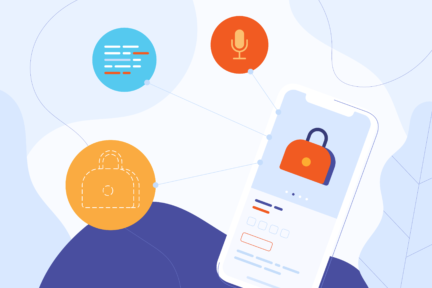AI is no longer a “nice to have.” It’s quickly becoming essential. Companies that are using AI automation tools for business are seeing real results—boosting efficiency by up to 30% and cutting overhead by as much as 25%, according to recent studies.
The takeaway? Businesses that act now are building a serious advantage. Those who hold off may find themselves playing catch-up.
Since the rise of generative AI, digital transformation hasn’t just accelerated – it’s jumped years ahead in a matter of months. Major players like Microsoft, Amazon, and Google are all-in on AI, seeing it as the next big shift. But this isn’t just a big-business game anymore. For growing companies, the question isn’t if you should bring AI automation tools into your business – it’s which tools will actually make a difference without disrupting what already works and drive business success.
What makes a great AI automation tool?
Not all tools for AI automation are equal. Some look impressive but don’t solve real problems. The ones that stand out do a few things really well:
- They fit easily into your existing systems
- They scale as you grow
- They show clear, measurable ROI
- They’re intuitive for your team to use
The right AI tools don’t just look impressive—they solve real problems. Whether automating support tickets, speeding up data entry, or simplifying analysis, the goal is the same: helping your team do more, faster.
Platforms like Salesforce and HubSpot are leading by example. They’ve added tools for AI automation where it counts – making their platforms more powerful, without making them more complicated.
How this guide helps you cut through the noise
The AI automation tool space is crowded – and growing fast. This guide is designed to help you make sense of it all.
We’ve done the research and curated a list of high-impact AI automation tools for business, covering five key areas where AI is driving real results:
- Document processing
- Customer support
- Business Intelligence
- Workflow automation
- Content & marketing
For each category, we highlight AI automation tools that go beyond the hype – tools that are actually improving operations and delivering measurable ROI. You’ll get a clear view of how these solutions work in practice, what outcomes to expect, and what to keep in mind before rolling them out. These tools are particularly effective in handling specific tasks, such as coding, data analysis, or customer support.
Whether you’re a CTO, Innovation Director, or business leader focused on scaling operations, this guide is built to give you the clarity and confidence to make smart, strategic AI decisions.
Need help choosing the right AI automation tools for business?
If you’re not sure where to start, we can help. At Miquido, we offer AI consulting services designed to help businesses of all sizes unlock the full potential of AI. From identifying the right tools to optimizing workflows and ensuring smooth implementation, our experts work closely with your team to build intelligent solutions tailored to your goals.
Whether you’re exploring AI for the first time or looking to scale what you’re already doing, we’ll help you get it right!
Top AI document processing tools: turning clutter into clarity
Document processing is one of the most practical and high-impact uses of AI in business today. Why? Because roughly 80% of your company’s information still lives in unstructured formats – contracts, invoices, reports, emails. It’s valuable data, but hard to use. AI is changing that by enabling the processing of both structured and unstructured data to provide comprehensive insights.
With intelligent document processing tools, you can turn those static files into structured, searchable, and actionable data that works with your systems.
And these AI automation tools for business have come a long way. We’ve moved beyond basic OCR. Today’s leading solutions use natural language processing to actually understand content, pulling out the important parts, recognizing context, and even suggesting next steps.
Real-world impact? Huge.
- JP Morgan slashed thousands of legal hours by using AI to review commercial loan documents in seconds.
- Loadsure uses Google Cloud’s AI to automate claims processing – extracting and classifying data with high accuracy. This speeds up settlements, reduces errors, and improves the customer experience.
- Covered California uses Document AI to automate parts of the application process, making it faster and easier for residents to submit documents and get verified, improving the experience for both consumers and staff.
- Thomson Reuters has added Gemini Pro to its approved AI tools, allowing employees to process entire documents in context. With a 2-million-token window, tasks are now up to 10 times faster.
Whether you’re managing financial records, HR paperwork, or customer contracts, the right document AI tool can remove bottlenecks, reduce manual work, and give your team better data to act on – faster.
Nanonets: Smart document processing that learns as you work
Nanonets is redefining what document processing can look like. It goes far beyond traditional OCR by using deep learning to actually understand the structure and content of documents, even when the formatting varies wildly.
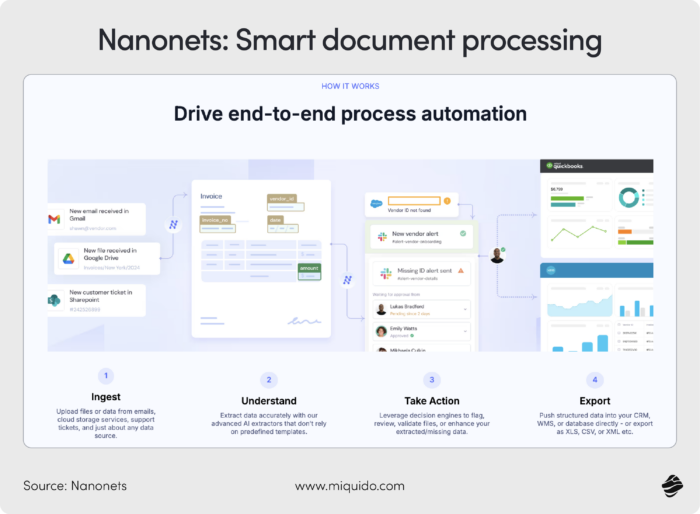
From invoices and receipts to contracts and forms, Nanonets handles it all with over 95% accuracy, even on unstructured documents. And because the AI automation tool learns with every document processed, it gets better over time – no retraining needed. Nanonets serves as a centralized platform that integrates various data sources and tools, facilitating data-driven decision-making and enhancing workflow automation.
Why it matters:
- Up to 80% faster processing times
- 65% fewer data entry errors
- Built-in adaptability for any document type
For example:
- Asian Paints used Nanonets to automate Accounts Payable, saving 192 hours/month and reducing invoice processing time by 90%
- A major government agency slashed tax refund turnaround from 24 weeks to 1 week – a 96% efficiency boost
- Suzano International reduced purchase order processing time from 8 minutes to just 48 seconds – a 90% reduction
Nanonets also fits well into complex tech environments. With an API-first design, this AI automation tool integrates seamlessly with platforms like SAP, Oracle, and Microsoft Dynamics, making it a strong choice for organizations that need flexibility and scale.
Microsoft Power Automate: Document AI made for the everyday team
Microsoft Power Automate brings AI-powered document processing into the hands of everyday business users – no coding required. Built on Microsoft’s low-code automation platform and backed by Azure Cognitive Services, it makes advanced AI accessible without needing a data science team.

At the heart of it is AI Builder, which lets teams train custom models for their own documents – think forms, applications, shipping records, and more.
What sets it apart:
- Low-code, no-code access to custom AI
- Smooth integration across Microsoft 365 and Dynamics
- Hundreds of ready-made connectors to business apps
Companies are already putting it to work:
- Uber Technologies migrated over 80 business processes and 40,000+ flows to Power Automate, streamlining operations at scale
- Aon Brazil CRS integrated Power BI, Power Apps, and Power Automate to reduce costs by 8% and cut deployment time by 80%
For organizations already invested in the Microsoft ecosystem, Power Automate offers one of the most practical AI-powered automation tools available today. It enables fast, efficient rollout of intelligent document workflows – without the burden of complex development or integration.
Getting implementation right: what to know before you start
Implementing document AI isn’t just about plugging in new software. Success depends on aligning tools with your systems – and your people.
Both Nanonets and Power Automate offer strong APIs and plug-and-play connectors for major business platforms. But don’t skip the testing phase. Make sure the AI automation tool plays nicely with your specific stack – especially if you’re dealing with legacy systems or custom workflows.
Human adoption
People are just as important as platforms. Clear communication is key—emphasise that AI is here to augment, not replace. Provide training that focuses not just on how to use AI automation tools but also on how roles will evolve when manual processing is removed from their plates.
Some companies appoint internal “AI champions” to lead by example, share wins, and support their teams through the change. This peer-driven approach often drives adoption faster than top-down mandates.
Set success metrics early
Efficiency gains are great, but don’t stop there. Track improvements in accuracy, compliance, employee satisfaction, and customer experience. These broader metrics give you a full picture of the impact and a roadmap for scaling success.
Leading AI Automation Tools for Customer Support
AI has changed the game for customer support. It’s no longer just about saving costs—it’s about delivering faster, more personalized service at scale. The best AI automation tools today, including AI-powered chatbots, handle everything from basic FAQs to complex support tickets while continuously learning and improving with every interaction.
Top platforms can now respond across email, chat, voice, and social media, keeping service consistent no matter how your customers reach out. And they don’t just react – they can predict problems before they escalate, making support more proactive than ever.
Companies like Spotify and American Express are already using AI to engage customers around the clock and worldwide. The results? Better experiences, faster resolutions, and fewer support headaches.
Intercom: Real-time, AI-powered automation tool for CS that gets smarter over time
Intercom has grown from a messaging tool into a full-service AI support platform that seamlessly blends automation and human help. Its Resolution Bot uses natural language understanding to resolve up to 33% of common support queries without needing a human agent.
What makes Intercom stand out is how it learns from real conversations. The AI improves its answers continuously and knows when to escalate complex issues to a person, enabling human-like conversations that keep interactions helpful, not robotic.

Where it’s making a difference:
- Anthropic saw a 96% AI involvement rate and achieved a 50.8% resolution rate in just over a month, saving approximately 1,700 hours within the first month of using Intercom.
- Clay reached up to a 50% resolution rate with a 90% AI involvement rate, managing around 7,000 support tickets per month through Intercom’s Fin AI Agent.
Intercom also offers rich analytics that reveal common friction points, helping product and support teams fix root issues instead of just treating symptoms.
Ada: No-code AI automation tool that speaks over 100 languages
Ada is built for teams who want to launch advanced, automated support without writing code. Its core strength lies in understanding intent, no matter how a customer phrases a question, thanks to Ada’s proprietary natural language processing engine.
This AI automation tool supports over 100 languages and can understand slang, idioms, and regional nuances, making it ideal for global brands. Ada leverages large language models to enhance its AI capabilities, enabling it to collaborate with humans on complex tasks and improve customer service efficiency through automated processes.

Real-world impact:
- monday.com achieved a 42% reduction in average agent handle time using Ada’s automated resolution capabilities. As Tal Gulst, Bot Manager, noted: “The responses and accuracy are phenomenal… there’s significant flexibility in making changes and improvements.”
- eposnow saved 60,000 hours of human labor per month by using Ada’s AI agent to automate support tasks.
Ada connects easily with tools like CRMs and order systems, so responses are always personalized and relevant – from billing and shipping updates to deep account queries.
Measuring ROI and customer experience the right way
To truly understand the value of AI-powered automation in customer support, it’s important to look beyond just faster response times or reduced costs. While those are meaningful wins, the real return on investment comes from something deeper: improved customer experience and long-term brand loyalty.
That’s why leading companies are shifting how they measure success, with a more complete set of metrics that capture operational efficiency and customer satisfaction.
What to measure:
- First-Contact Resolution
Can the AI solve the problem without needing a human to step in?
Take Klarna, for example. Their AI chatbot now handles two-thirds of all customer service inquiries – work that used to require the equivalent of 700 full-time agents. In just its first month, it handled 2.3 million conversations, contributing to a projected $40 million profit improvement. That’s not just efficiency – it’s scale. - CSAT for Automated Interactions
Do customers walk away from an AI-driven conversation feeling truly helped?
Comcast rolled out “Ask Me Anything”, an automation AI tool that supports agents in real-time. The result? Agents reported positive feedback from customers nearly 80% of the time. That’s a strong signal that AI can elevate, not just speed up, support experiences. - Self-Service Adoption
Are more customers able to solve issues on their own, without escalating?
Definity Insurance introduced AI-powered call summarization, reducing call lengths by an average of three minutes. That extra time gives advisors more bandwidth to focus on what matters – delivering great service.
By focusing on these comprehensive metrics, businesses can better assess the true value of automation—not just in numbers but also in customer trust, satisfaction, and long-term growth.
Powerful Business Intelligence AI tools: Turning data into decisions
AI has completely reshaped how businesses approach analytics. Where traditional BI tools looked backwards, modern AI-driven platforms look forward, offering predictive insights, spotting hidden trends, and enhancing decision-making through data analysis.
More importantly, these AI automation tools are no longer just for analysts. With natural language queries, smart visualizations, and built-in machine learning, business intelligence is now accessible across departments – from marketing to operations to the C-suite.
It’s no surprise that, according to Gartner, 79% of corporate strategists see AI and analytics as critical to their success over the next two years.
Here are the tools driving that edge.
Looker: Transforming data into business conversations
Looker, now part of Google Cloud, is more than just a business intelligence tool – it’s a platform that helps teams make data-driven decisions by turning complex datasets into accessible, actionable insights.
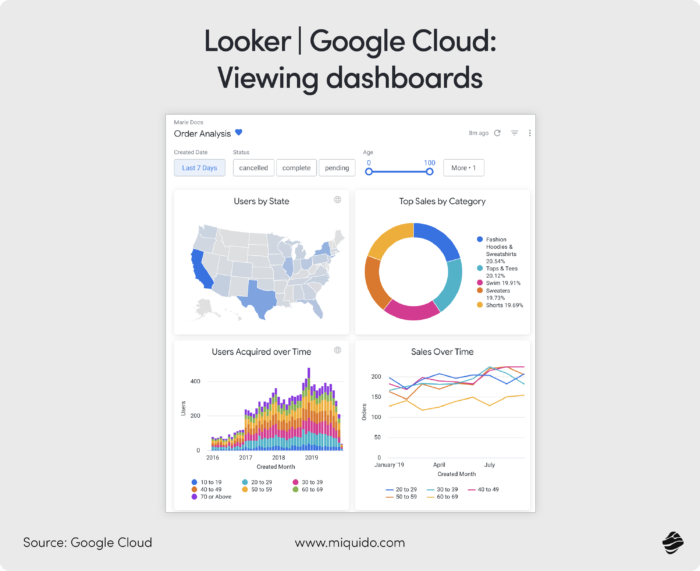
At the heart of Looker is LookML, a unique modeling language that transforms complex business data into business-friendly terms. That means anyone on your team can explore data, ask smart questions, and get trusted answers – without needing to write SQL or dig into backend systems.
Looker gives teams one platform to:
- Explore data and build dashboards
- Define metrics and business logic in a structured, scalable way
- Build custom data experiences using APIs and embedded analytics
Your data stays where it is—securely in your database—while Looker queries it in real time. Whether you deploy on Google Cloud, another provider, or your own infrastructure, you stay in control of your data environment.
For companies managing messy, disconnected data systems, Looker brings everything together in one place. It bridges the gap between technical and business teams, so everyone works from the same source of truth when it comes to metrics, performance, and planning.
And with its support for AI-powered analytics, Looker helps organizations shift from gut-based decisions to smart, data-backed strategies – at every level.
Akkio: No-code predictive AI automation tool for business teams
Akkio takes the complexity out of predictive analytics. With its no-code platform, teams can upload data, ask business-critical questions – like forecasting demand or predicting churn – and get instant, accurate models. No developers or data scientists required.
Designed specifically for advertising and marketing teams, Akkio’s platform helps agencies and businesses move faster, make smarter decisions, and maximize performance across the campaign lifecycle.
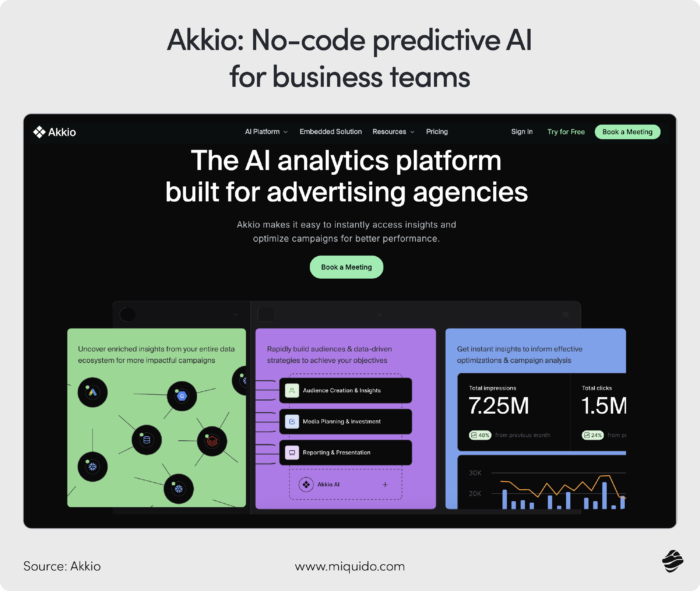
Real-world impact:
- Management One doubled output and cut reporting workload by 70% using Akkio’s no-code predictive AI.
- LA/VIE used Akkio’s predictive models to boost client ROAS by 208% and double revenue per client – without increasing ad spend.
Whether you’re optimizing campaigns, identifying new audiences, or automating insights, Akkio delivers the speed and intelligence your team needs to drive better outcomes, without the technical barriers.
Tableau: Beautiful dashboards with brainpower behind them
Tableau, from Salesforce, helps teams see and understand data fast. Its drag-and-drop interface and powerful visual dashboards make it easy for anyone to analyze data, uncover insights, and share results in seconds – no coding required.
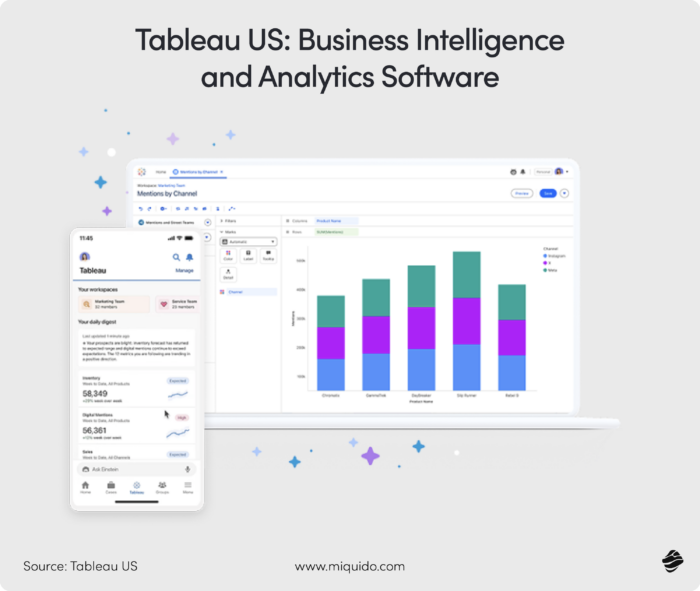
Whether you’re working with spreadsheets, databases, cloud platforms, or big data tools, Tableau connects to virtually any data source. It delivers real-time insights and keeps dashboards automatically updated, so you’re always working with the latest information.
Real-world use cases:
- Nissan North America used Tableau to spark a data-first culture, turning everyday reports into clear, actionable insights that led to smarter decisions across teams.
- Red Hat rolled out Tableau to more than 4,500 employees, accelerating its data transformation and empowering every department to act on insights faster.
With its intuitive interface, cross-platform compatibility, and enterprise-grade scalability, Tableau stands out as one of the top tools for AI-powered analytics. It helps organizations democratize data and drive performance through insight, not guesswork.
Power BI: Enterprise-ready intelligence with Microsoft DNA
Power BI, from Microsoft, helps teams turn data into decisions quickly and confidently. With an easy-to-use report builder, AI-powered features, and deep integration with Microsoft 365, Power BI brings advanced analytics to every corner of the organization.
This AI-powered automation tool connects to virtually any data source, creates real-time dashboards, and embeds insights directly into the tools your teams use every day – from Excel and Teams to Dynamics 365.

Real-world impact:
- Jacobs used Power BI to build a global, data-driven culture focused on solving complex client challenges at scale.
- Kraft Heinz leveraged Power BI to deliver client insights directly to decision-makers, streamlining communication and accelerating action.
With enterprise-level governance, seamless interoperability, and built-in AI features, Power BI stands out as one of the most trusted artificial intelligence automation tools for organizations that want insight to drive impact, without compromise.
Final thoughts: Business Intelligence that drives action
AI-powered business intelligence tools today aren’t just for tracking performance – they’re built to drive smarter, faster decisions. The best AI automation tools don’t just visualize your data. They help you understand it, act on it, and stay ahead of what’s coming next.
Whether you need a no-code solution like Akkio, advanced modelling with Looker, or enterprise-scale integration through Power BI, the right tool depends on your data maturity, team capabilities, and growth goals.
How to maximize the value of BI + AI
The real power of business intelligence and automation tools using AI is in turning them into action.
High-performing companies don’t stop at analysis. They build systems that either act on insights automatically or translate them into clear, repeatable workflows. The result? Faster decisions, more agility, and measurable outcomes.
So, what sets high-performing organizations apart?
- Data is everyone’s job. Companies like Amazon and Netflix treat data literacy as a baseline skill, not just for analysts, but for every team across the business.
- Training drives adoption. At IBM and Microsoft, structured programs that combine tool training with analytical thinking have led to up to 60% higher adoption of AI and BI tools.
- Collaboration unlocks value. Cross-functional “insight teams” pair data experts with domain specialists, ensuring AI-driven insights are not only statistically sound but also operationally actionable.
To truly get value from AI-powered automation tools, organizations need to treat data as a strategic asset – and equip every team to use it with confidence. That means investing in the right tools, building a culture of curiosity, and creating the conditions where insight turns into impact.
Essential workflow automation AI solutions
According to McKinsey, employee disengagement and attrition could cost a median-sized S&P 500 company between $228 million and $355 million annually in lost productivity. Over five years, that’s more than $1.1 billion in value gone, not from big failures, but from the drag of inefficient processes and underused talent.
Much of this comes down to time wasted on low-value work: manual data entry, repetitive status updates, and clunky handoffs. Automation tools using AI are stepping in to remove that friction by automating routine tasks – freeing teams to focus on higher-impact work.

And today’s platforms go well beyond static workflows. The latest solutions leverage generative AI to adapt in real time, learn from usage patterns, and make intelligent, context-aware decisions.
Whether it’s automating loan processing in finance or optimizing production schedules in manufacturing, AI-driven workflow automation tools helps businesses move faster, smarter, and with greater precision.
Zapier: Easy automation with serious intelligence
Zapier is one of the most widely adopted automation tools using AI, helping businesses connect apps, automate tasks, and eliminate repetitive manual work – without writing a single line of code.
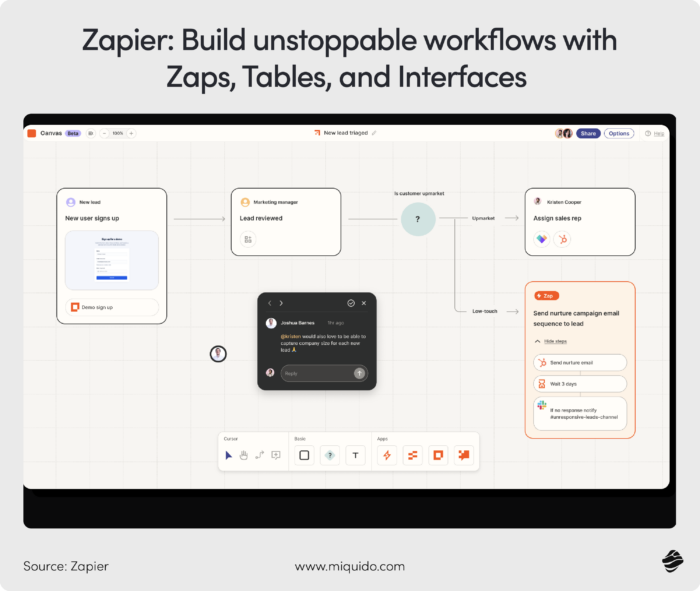
With over 7,000 app integrations, Zapier makes it easy to create automated workflows—called Zaps—that move information across platforms and trigger actions instantly. Whether it’s syncing leads from forms to CRMs, sending alerts, or updating spreadsheets, Zapier’s drag-and-drop functionality helps teams work smarter, not harder.
Why it works:
- Automates tasks across tools like Slack, Salesforce, Asana, HubSpot, and Google Sheets
- No-code interface designed for business users, not developers
- Scales easily with templates, conditional logic, and multi-step workflows
Real-world results:
From startups to enterprise teams, Zapier lets organizations build robust automations without relying on IT resources – turning everyday tools into intelligent systems.
- Zendesk’s Adam O’Donnell used Zapier to automate podcast workflows, saving 5+ hours weekly and boosting guest referrals by 70%.
- Calendly uses Zapier to save 10+ hours weekly, speed up lead response, and improve customer satisfaction by syncing feedback between teams.
Make: AI-powered automation tool that adapts to your business
Make is a powerful no-code automation platform designed to help businesses move beyond simple integrations. Whether you’re automating a single task or building a sophisticated, multi-step workflow, Make offers the flexibility to design systems that reflect how your business actually operates, without touching a line of code.
What sets Make apart is how seamlessly it integrates AI-driven tools into everyday operations. It works with leading AI models like GPT, Claude, and Gemini, so your workflows don’t just move faster – they work smarter.
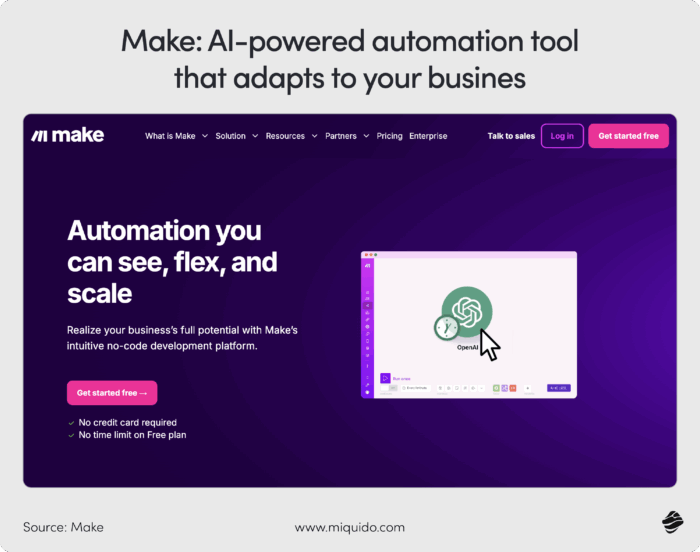
With Make’s visual drag-and-drop interface, anyone can build workflows – no technical skills needed. It connects with over 2,000 apps and services, letting your data move freely and efficiently across tools.
Here’s what you can do with Make:
- Trigger workflows based on real-time events
- Add AI-powered decision points
- Connect multiple tools into one seamless process
And with built-in features like:
- AI Assistant: Build or adjust workflows using natural language
- Custom Prompts: Tailor AI behavior to your specific goals
- Templates & Transformers: Launch quickly or fine-tune your automation in detail
Make is flexible enough to support everything from marketing and customer support to onboarding and internal operations. However your team works – Make helps them work smarter.
Businesses across industries are already using Make to turn automation into meaningful results:
- Sommo: Built an AI-powered Software Requirements Generator in just one day using Make. Results: 800+ additional leads per month, 5× increase in site engagement.
- GoJob: Automated hiring workflows to eliminate repetitive tasks. Results: 96% drop in call volume, up to 50% year-over-year revenue growth.
This is what automation looks like when it’s built to scale – and made for real-world impact.
Need help building with make?
At Miquido, we help companies unlock the full potential of Make. From mapping out your automation strategy to building AI-enhanced workflows tailored to your business, our team ensures you get the most out of the platform – quickly and efficiently.
n8n: Flexible AI automation tool built for technical teams
n8n is a flexible AI automation tool built for technical teams who need both speed and control. With a visual workflow builder, you can create powerful automations in minutes – and when things get more complex, you can dive into code using JavaScript, Python, or cURL to handle complex tasks effectively.
Unlike rigid automation tools, n8n gives you the freedom to build workflows your way. Connect over 400 apps, layer in multi-step logic, and bring AI directly into your workflows. Whether you’re automating routine IT operations, transforming raw data into insights, or building smart AI agents, n8n adapts to your process – not the other way around.

What sets n8n apart is how well it balances usability and power. The visual interface helps teams move fast, while built-in support for code gives you precision when you need it. It’s fully self-hostable, so your data stays exactly where you want it. And with AI integrations like GPT and Claude, you can automate decision-making, generate summaries, or build intelligent agents – all in one place.
n8n also connects with over 400 tools – from GitHub and Slack to Salesforce and internal databases. You can start from prebuilt templates or design your own flows from scratch. Real-time testing and debugging make it easy to tweak and relaunch without slowing down your team.
Real-world wins:
- Delivery Hero saved over 200 hours/month by automating a single IT ops workflow.
- Stepstone runs 200+ mission-critical workflows on n8n, cutting data integration time from 2 weeks to 2 hours – a 25x speed boost.
For companies scaling automation across departments, n8n offers everything you need: secure deployment with SSO, encrypted secrets, and audit trails; multi-user collaboration with isolated environments; Git integration for workflow versioning; and the ability to embed n8n into your own product to power automation for customers.
n8n gives technical teams the tools to move fast, stay flexible, and build workflows on their terms – all without compromising control or security.
Identifying processes ripe for AI workflow automation
When it comes to workflow automation, the biggest wins come from choosing the right starting points. Automating just any task won’t cut it – you need to focus on the areas where AI automation tools for business will drive real return on investment.
High-impact organizations approach this strategically. They begin with a clear-eyed assessment of their operations, looking at processes through key criteria:
- How often does it happen? (High-volume = high potential)
- Is it repetitive or rules-based?
- Does it involve frequent errors?
- Is it strategically important to the business?
What often surprises teams during this review is how many “small” tasks add up – things that seem minor individually but collectively eat up hundreds or thousands of hours across departments.
Rethink, don’t just replicate
The companies seeing the most transformative results aren’t just automating old processes – they’re redesigning them with AI in mind.
At Amazon, for example, teams start by asking: “How would this work if it were built for AI from the ground up?” Not: “How can we automate what we already do?”
That shift in thinking opens the door to removing unnecessary steps, many of which only existed because humans had to do the work manually. AI doesn’t get tired, distracted, or bogged down by complexity, so the process can be smarter, faster, and cleaner from the start.
Think end-to-end, not just department-by-department
Another key insight? Look beyond individual tasks or teams. AI automation delivers more value when it spans entire value streams – connecting the dots across systems and silos.
Take sales proposals, for example. The real power comes not just from automating document generation, but from building a seamless workflow that runs from:
- Lead qualification
- Proposal creation
- Approval routing
- Contract generation
- E-signature collection
This kind of connected AI automation turns what used to be a manual, multi-touch process into a streamlined, intelligent engine that works across marketing, sales, legal, and ops – unlocking speed and scale.
If you want an AI automation tool to deliver meaningful results, don’t just automate what’s easy—automate what matters. Start with a focused process audit, challenge existing assumptions, and design workflows for how AI can work, not just how humans did work.
At Miquido, we help companies identify, design, and deploy AI-powered automation where it has the biggest impact. Whether you’re just beginning your automation journey or scaling across departments, we partner with your team to:
- Audit and prioritize automation opportunities
- Reimagine workflows with AI at the core
- Build scalable systems using tools like n8n, Make, and beyond
- Ensure speed, security, and seamless integration with your stack
Innovative content and marketing automation tools using AI
Content and marketing are no longer just creative functions – they’re now powered by AI automation tools to scale production, personalize messaging, and increase engagement across every channel.
As the demand for always-on content grows, especially across social, email, eCommerce, and web platforms, AI tools are stepping in to help teams produce more, without sacrificing quality. These tools do far more than just generate text or graphics. They’re built to reflect your brand voice, adapt to your audience, and optimize for conversion, including creating engaging social media posts.
- E-commerce brands are using AI to write tailored product descriptions, boosting conversion rates by 10–15%.
- B2B marketers are building personalized email campaigns that evolve in real time based on user engagement, and some are seeing 40%+ increases in response rates.
The result? Less time spent writing, more time spent refining strategy.
Jasper.ai: Enterprise-grade content creation at scale
Jasper is one of the most advanced AI automation tools built specifically for marketing teams. More than just a writing tool, Jasper helps you produce high-quality content – fast – across blogs, ads, emails, product pages, and social media. Everything it creates is designed to sound like you, stay on-brand, and drive real results.
Unlike basic AI generators, Jasper is trained with marketing in mind. That means it doesn’t just spit out grammatically correct copy – it writes content that converts, speaks to your audience, and supports your goals. Jasper also offers customizable templates that cater to a variety of design needs, enhancing both the speed and efficiency of the content creation process.
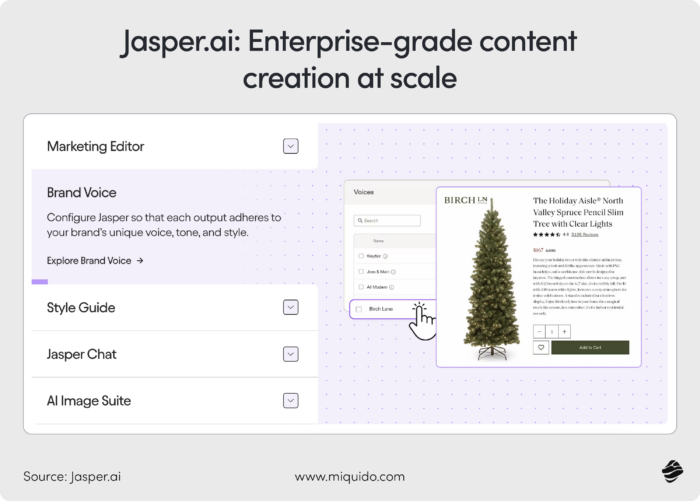
How it’s being used:
- Mongoose Media, a digital agency based in Orlando, published over 40 blog posts in six months for a client, a level of output CEO Lauren Petrullo said would have been impossible without Jasper.
- Amplitude used Jasper to dramatically cut content creation costs compared to hiring an agency, freeing up their SEO team to focus on strategy rather than production.
From long-form blogs to punchy headlines and engaging YouTube scripts, Jasper helps marketers create consistent, effective content across every channel, without losing the voice that makes their brand stand out.
Copy.ai: Fast, format-specific content generation
Copy.ai is more than a content generator – it’s a complete GTM AI platform designed to power every part of your go-to-market engine. With 30+ free AI tools and built-in workflows for sales, marketing, and operations, teams can move faster, create smarter, and eliminate the sprawl of disconnected tools.
Whether you’re building sales emails, blog posts, landing pages, or personalized campaigns, Copy.ai delivers high-quality, format-specific content in seconds – no manual prompting required.

See it in action:
“We’re generating 5x more meetings with our personalized, AI-powered GTM strategy.”
– Jean English, CMO @ Juniper Networks
“By automating content workflows that used to take weeks and cost thousands through agencies, we’ve saved $16M this year alone.”
– Roman Olney, Head of Global Digital Experience @ Lenovo
Rather than juggling AI copilots or patching together one-off tools, Copy.ai gives GTM teams a connected, enterprise-ready platform to support every use case – from outbound sales and ABM to content strategy and lead processing.
Balancing automation and human creativity
As AI content tools become more powerful, the real question isn’t whether to use them – it’s how to use them wisely. The most effective organizations don’t see AI as a replacement for creativity. They see it as a creative partner – one that accelerates execution with minimal effort, enhances consistency, and frees up human talent to focus on what machines can’t replicate: big ideas, emotion, and brand voice.
AI shines when it’s used to generate variations, adapt formats, and maintain brand consistency at scale. But when it comes to storytelling, emotional nuance, and strategic messaging, humans still lead.
Companies like Pixar and Netflix are great examples. They use AI to streamline production tasks, like content localization or variation generation, while keeping core creative direction and emotional storytelling firmly in the hands of people. This division of labor plays to each side’s strengths and results in better, more scalable content.
Redefining creative roles
As content automation takes on more of the “production lift,” it creates space for creative teams to level up. Instead of reducing headcount, forward-thinking companies are reimagining creative roles around:
- Concept development
- Brand storytelling
- Campaign strategy
- Cross-channel creative direction
AI handles the execution. Humans focus on ideas, insights, and differentiation.
This shift often requires not just new artificial intelligence automation tools – but new training and a new mindset. Companies that invest in both technology and talent development are the ones seeing real creative breakthroughs – not just more content.
Evaluating and selecting the right automation tools using AI
A lot of AI evaluations stop at flashy demos – but that’s just the surface. If you want tools that truly move the needle, dig deeper with a clear framework, keeping in mind the learning curve that new users must navigate to fully leverage the software’s capabilities.
Ask the right questions:
- Does it solve a real problem?
- Can we integrate it smoothly with what we already have?
- Will it scale as we grow?
- How quickly will we see results?
- What’s the real cost, including setup, training, and support?
Take a page from leaders like Uber. They reduce risk by rolling out in stages:
- Quick internal review
- Small pilot with real data
- Controlled rollout with clear success metrics
This phased approach builds confidence and avoids overcommitting too early.
Remember: You’re not just buying software. You’re entering a partnership. Look for vendors who are stable, responsive, and aligned with your long-term goals.
Security & compliance: No room for compromise
If you’re dealing with sensitive data or operate in a regulated space, security isn’t a feature, it’s a requirement. Data privacy is crucial to protect sensitive information and adhere to compliance regulations. Before you commit, make sure you know:
- Where is your data stored?
- Is it encrypted? Who has access?
- Can the system be audited?
- What happens if something goes wrong?
Frameworks like the NIST AI Risk Management Framework and the EU AI Act are setting the tone globally, with a focus on:
- Transparent decision-making
- Ongoing bias monitoring
- Human oversight for high-stakes decisions
Compare your vendor’s security posture to benchmarks from leaders like Google or Microsoft. And be aware of newer risks, like prompt injection and model manipulation. Your tools need to be ready.
Building a real ROI case
Not every return shows up on a balance sheet – but that doesn’t make it less valuable. By automating tasks, companies can significantly reduce their operational costs, leading to a more streamlined and cost-effective operation.
Look at both sides of ROI:
- Tangible value: Cost savings, faster workflows, fewer manual tasks
- Strategic value: Better decisions, more engaged teams, stronger customer experience
Firms like McKinsey and PwC use a phased approach:
- Define a baseline
- Track early wins, like user adoption
- Review results often and adjust
Als,o consider the cost of waiting. Delay can mean losing ground to faster-moving competitors.
AI-powered automation is all about your people
The best AI solution won’t succeed without buy-in. People need to:
- Understand AI is here to help, not replace them
- Build the right skills to use it effectively
- Be involved early and often in knowledge management to enhance productivity and organization
Train for every level:
- IT teams: How to deploy and manage systems
- Business users: How to apply AI in daily work
- Managers: How to lead AI-powered teams
Companies like Amazon and Google invest in layered learning, mixing foundations, hands-on training, and real-world use cases. Some are even creating new roles like AI Solution Architects to bridge business needs with tech solutions.
Start Small. Think Big. Move Fast.
You don’t need a sweeping transformation to see the value of AI-powered automation tools. The companies making the most progress aren’t trying to do everything at once. They start with focused pilots that solve specific problems, deliver quick wins, and build momentum through strategic AI-driven automation.
But before anything launches, define what success actually looks like. That means setting clear metrics like cost savings or time reductions, but also tracking softer signals, like how easily people adopt the tool or how it improves workflows. Done right, every pilot becomes a stepping stone to broader impact.
Then, step back and think long term
Pilots spark progress. But strategy is what sustains it.
To make AI a lasting advantage, zoom out and ask: How will this change the way businesses operate? What kind of customer experiences could we now offer? What new ideas or business models could this unlock?
The most forward-thinking organizations use scenario planning to prepare for evolving AI capabilities and stay ahead of changing regulations and markets.
And as your AI capabilities grow, you’ll face a critical decision: should you build in-house, or buy a ready-made solution?
Off-the-shelf tools often work well for common use cases, like chatbots or process automation. But when AI touches something that gives you a competitive edge – your proprietary data, your unique workflows, or how you serve customers – a custom AI development service can be a better investment.
This isn’t just a question of cost. It’s about long-term fit. Consider how fast your needs might evolve, what internal expertise you’ll need to maintain it, and how closely the tool has to align with your business.
Your roadmap is your advantage
AI isn’t just another tool. It’s an indispensable tool for growth. But it works best when guided by purpose, not hype.
The companies seeing real results do five things consistently: they start with quick, focused pilots. They align AI with their broader business goals. They invest in people just as much as platforms. They know when to build and when it’s smarter to buy. And they treat AI as a strategic priority, not just a tactical fix.
Whether you’re just getting started or scaling up, the key is to make every step intentional. Because when applied thoughtfully, AI amplifies what your business already does best.
AI Automation Tools Consulting at Miquido
At Miquido, we help businesses cut through the noise and find AI automation tools that actually work – for your goals, your data, and your workflows. We specialize in identifying solutions like an AI meeting assistant that can automate and enhance various aspects of meeting management, including note-taking, transcription, and summarization.
We don’t just recommend software. We help you build a roadmap that drives results:
- We start by evaluating your needs and identifying tools that offer real value – no buzzwords, just solutions that work.
- Then we help you prioritize high-impact opportunities through a clear automation strategy, backed by feasibility and ROI analysis.
- Before scaling, we test selected tools in real use cases, so you can validate performance, integration, and impact.
- Once proven, we support smooth integration, embedding AI into your operations with minimal disruption and maximum benefit.
And we never overlook the critical stuff: governance, compliance, and risk.
- From day one, we help ensure your AI initiatives are secure, ethical, and future-proof.
If you’re unsure where to begin with AI automation, let’s make it simple, practical, and results-driven.
Book a free consultation and start automating smarter.




